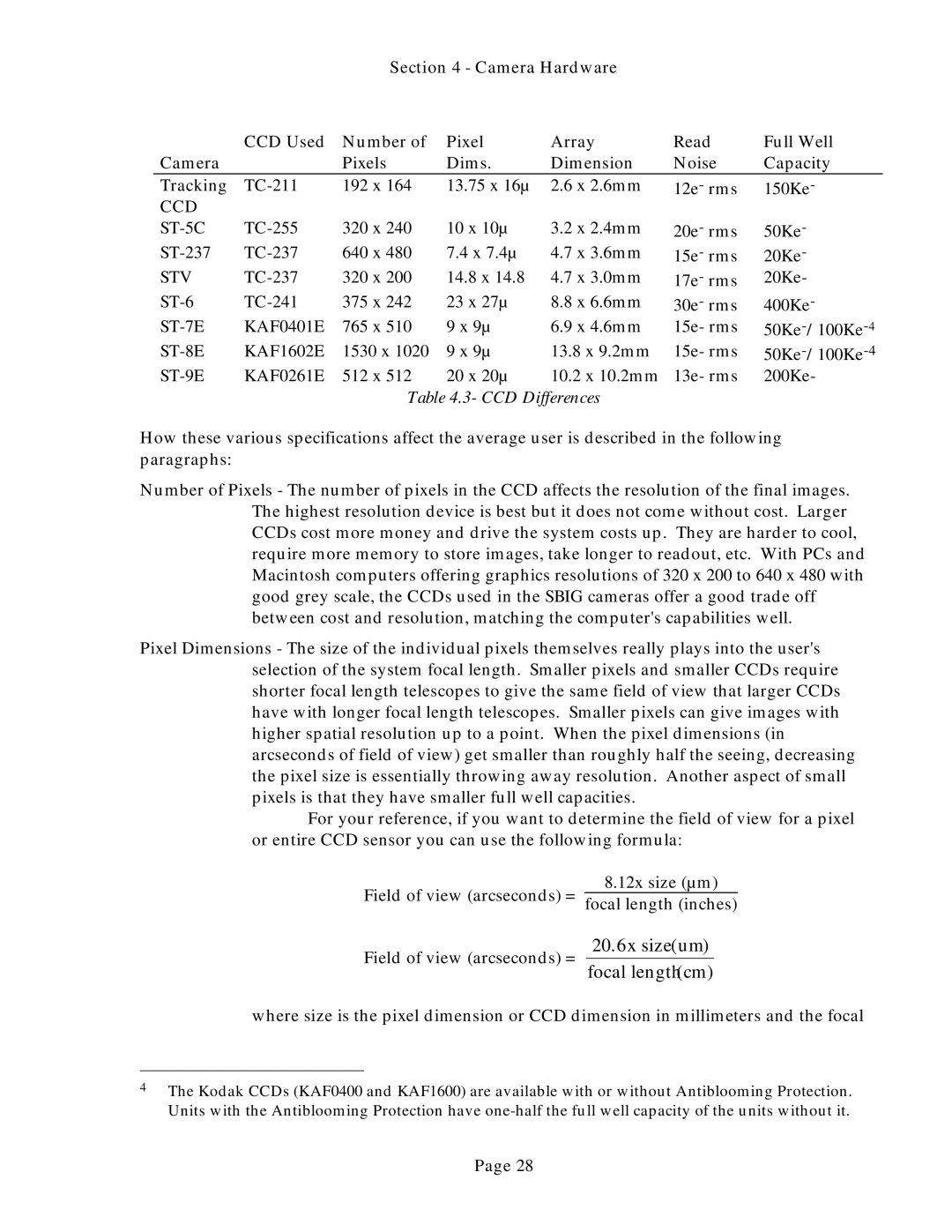
|
| Section 4 - Camera Hardware |
|
| ||
| CCD Used | Number of | Pixel | Array | Read | Full Well |
Camera |
| Pixels | Dims. | Dimension | Noise | Capacity |
Tracking | 192 x 164 | 13.75 x 16µ | 2.6 x 2.6mm | 12e- rms | 150Ke- | |
CCD |
|
|
|
| 20e- rms | 50Ke- |
320 x 240 | 10 x 10µ | 3.2 x 2.4mm | ||||
640 x 480 | 7.4 x 7.4µ | 4.7 x 3.6mm | 15e- rms | 20Ke- | ||
STV | 320 x 200 | 14.8 x 14.8 | 4.7 x 3.0mm | 17e- rms | 20Ke- | |
375 x 242 | 23 x 27µ | 8.8 x 6.6mm | 30e- rms | 400Ke- | ||
KAF0401E | 765 x 510 | 9 x 9µ | 6.9 x 4.6mm | 15e- rms | ||
KAF1602E | 1530 x 1020 | 9 x 9µ | 13.8 x 9.2mm | 15e- rms | ||
KAF0261E | 512 x 512 | 20 x 20µ | 10.2 x 10.2mm | 13e- rms | 200Ke- | |
Table 4.3- CCD Differences
How these various specifications affect the average user is described in the following paragraphs:
Number of Pixels - The number of pixels in the CCD affects the resolution of the final images. The highest resolution device is best but it does not come without cost. Larger CCDs cost more money and drive the system costs up. They are harder to cool, require more memory to store images, take longer to readout, etc. With PCs and Macintosh computers offering graphics resolutions of 320 x 200 to 640 x 480 with good grey scale, the CCDs used in the SBIG cameras offer a good trade off between cost and resolution, matching the computer's capabilities well.
Pixel Dimensions - The size of the individual pixels themselves really plays into the user's selection of the system focal length. Smaller pixels and smaller CCDs require shorter focal length telescopes to give the same field of view that larger CCDs have with longer focal length telescopes. Smaller pixels can give images with higher spatial resolution up to a point. When the pixel dimensions (in arcseconds of field of view) get smaller than roughly half the seeing, decreasing the pixel size is essentially throwing away resolution. Another aspect of small pixels is that they have smaller full well capacities.
For your reference, if you want to determine the field of view for a pixel or entire CCD sensor you can use the following formula:
8.12x size (µm)
Field of view (arcseconds) = focal length (inches)
Field of view (arcseconds) =
20.6x size(um)
focal length (cm)
where size is the pixel dimension or CCD dimension in millimeters and the focal
4The Kodak CCDs (KAF0400 and KAF1600) are available with or without Antiblooming Protection. Units with the Antiblooming Protection have
Page 28
